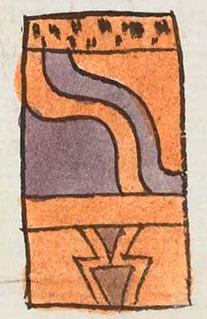huehuetl (Mdz28r)
This element has been carved from the compound sign for the place name, Tehuehuec. It is an upright drum (huehuetl) probably made of wood even though the wavy bands of terracotta and purple colors suggest stone. The stone here points to the Te- of the place name, and it does not mean to convey that this particular type of drum was carved from stone. The top of the drum has a jaguar skin covering. The bottom has stepped-shape cutouts, which provide the (typically three) legs for the drum.
Stephanie Wood
This percussion instrument could be struck with the human hand or with a mallet. Here is a website that provides considerable information about the drum, including photographs of surviving huehuetl and images from codices.
Stephanie Wood
c. 1541, but by 1553 at the latest
Stephanie Wood
drums, atabales, huehuetes, tambores, madera, vertical

huehue(tl), upright wooden drum, https://nahuatl.wired-humanities.org/content/huehuetl
el atabal
Alonso de Molina
Codex Mendoza, folio 28 recto, https://digital.bodleian.ox.ac.uk/objects/2fea788e-2aa2-4f08-b6d9-648c00..., image 66 of 188.
The Bodleian Libraries, University of Oxford, hold the original manuscript, the MS. Arch. Selden. A. 1. This image is published here under the UK Creative Commons, “Attribution-NonCommercial-ShareAlike 3.0 License” (CC-BY-NC-SA 3.0).




